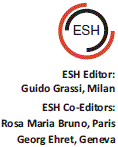Context
Recently, interesting novel data on the target blood pressure (BP) for treatment in older patients with hypertension were reported by the STEP (Strategy of Blood Pressure Intervention in the Elderly Hypertensive Patients) study investigators [Citation1].
Discussion
STEP is a randomised controlled trial (RCT) conducted in China that randomised 8,511 patients in a 1:1 ratio to either a target systolic BP (SBP) corridor between 110 mmHg and 130 mmHg (intensive treatment group) or a corridor between 130 and 150 mmHg (standard treatment group). Patients of Han ethnicity aged 60–80 years and with baseline SBP values between 140 and 190 mmHg or on antihypertensive treatment were eligible. Medications used to target the SBP in both groups included olmesartan, amlodipine and hydrochlorthiazide, in agreement with the core treatment strategy recommended in the 2018 European hypertension guidelines [Citation2]. The primary endpoint of the study was a composite endpoint of six items including stroke, acute coronary syndrome, acute decompensated heart failure, coronary revascularization, atrial fibrillation, or death from cardiovascular causes. The mean baseline SBP was 146 mmHg, the mean achieved SBP was 135.9 mmHg in the standard and 126.7 mmHg in the intensive treatment group (mean difference 8.4 mmHg). After a mean follow up of 3.3 years, the composite endpoint was reduced by 26% in the intensive treatment group compared to the standard treatment group (95% confidence interval (CI) 0.60–0.92; p = 0.007). In sub-group analyses, the benefit was observed in patients 60–69 years (25% risk reduction) and 70–80 years old (27% risk reduction). Total mortality was not significantly different, though numerically higher (67 vs. 64 events) in the intensive treatment group.
STEP is an important study and adds further evidence to support a lower SBP target (<130 mmHg in older patients). However, similar to other RCTs, some limitations warrant a note of caution. First, in the standard treatment group, the SBP target values were between 130 and 150 mmHg, which, though in line with 2013 ESH/ESC guidelines at the time the study was planned, is higher than the currently recommended target [Citation2] for patients of this age group (140 mmHg). Second, patients over 80 years old were not included in STEP, and the patient group between 70 and 80 years old represented only about one quarter (24.2%) of the study population. Third, due to the study design, BP lowering drugs may have been discontinued or down-titrated in the standard treatment group, therefore potentially contributing to the increased risk in this group, which also applies to other studies with a similar design including the SPRINT study (Systolic Blood Pressure Intervention Trial) [Citation3] as recently discussed [Citation4]. Finally, as evident from , patients with several comorbidities or conditions that are frequently observed in clinical practice in older individuals [Citation5,Citation6] were excluded from the study.
Table 1. Selected exclusion criteria in the STEP study which are relevant in older patients.
Conclusion
The STEP study provides only partial evidence for the older patients: evidence is still missing for patients older than 80 years and only limited evidence for frail patients and/or patients with relevant co-morbidities between 60 and 80 years of age. In light of the steady increase in the number of older patients with hypertension requiring appropriate care, the ESH has just established a new working group section in 2022 to address the pressing issue (see ESH News Corner). With the help of this working group section, ESH aims to develop a further step forward for hypertension management in older people.
Key points
•The STEP study provides new evidence for improved outcomes with a systolic BP target of <130 mmHg in the older patients below 80 years.
•The findings may be partially driven by systolic BP values of >140 mmHg in the comparison group, such values are no longer recommended by the ESH for this age group.
•Although the effect is consistent between the age groups, fewer participants >70 years were included and no participant was >80 years old.
•Frequent co-morbidities in the older individuals were exclusion criteria, limiting the proven generalisability of the results.
References
- Zhang W, Zhang S, Deng Y, et al. Trial of intensive blood-pressure control in older patients with hypertension. N Engl J Med. 2021;385(14):118–1279.
- Williams B, Mancia G, Spiering W, et al. 2018 ESC/ESH guidelines for the management of arterial hypertension: the task force for the management of arterial hypertension of the European Society of Cardiology and the European Society of Hypertension: the task force for the management of arterial hypertension of the European Society of Cardiology and the European Society of Hypertension. J Hypertens. 2018;36(10):1953–2041.
- Group SR, Wright JT, Jr., Williamson JD, et al. A randomized trial of intensive versus standard blood-pressure control. N Eng J Med. 2015;373(22):2103–2116.
- Brunstrom M, Thomopoulos C, Carlberg B, et al. Methodological aspects of meta-analyses assessing the effect of blood pressure-lowering treatment on clinical outcomes. Hypertension. 2022;79(3):491–504.
- Benetos A, Rossignol P, Cherubini A, et al. Polypharmacy in the aging patient: management of hypertension in octogenarians. JAMA. 2015;314(2):170–180.
- Schneider J, Algharably EAE, Budnick A, et al. High prevalence of multimorbidity and polypharmacy in elderly patients with chronic pain receiving home care are associated with multiple medication-related problems. Front Pharmacol. 2021;12:686990.


